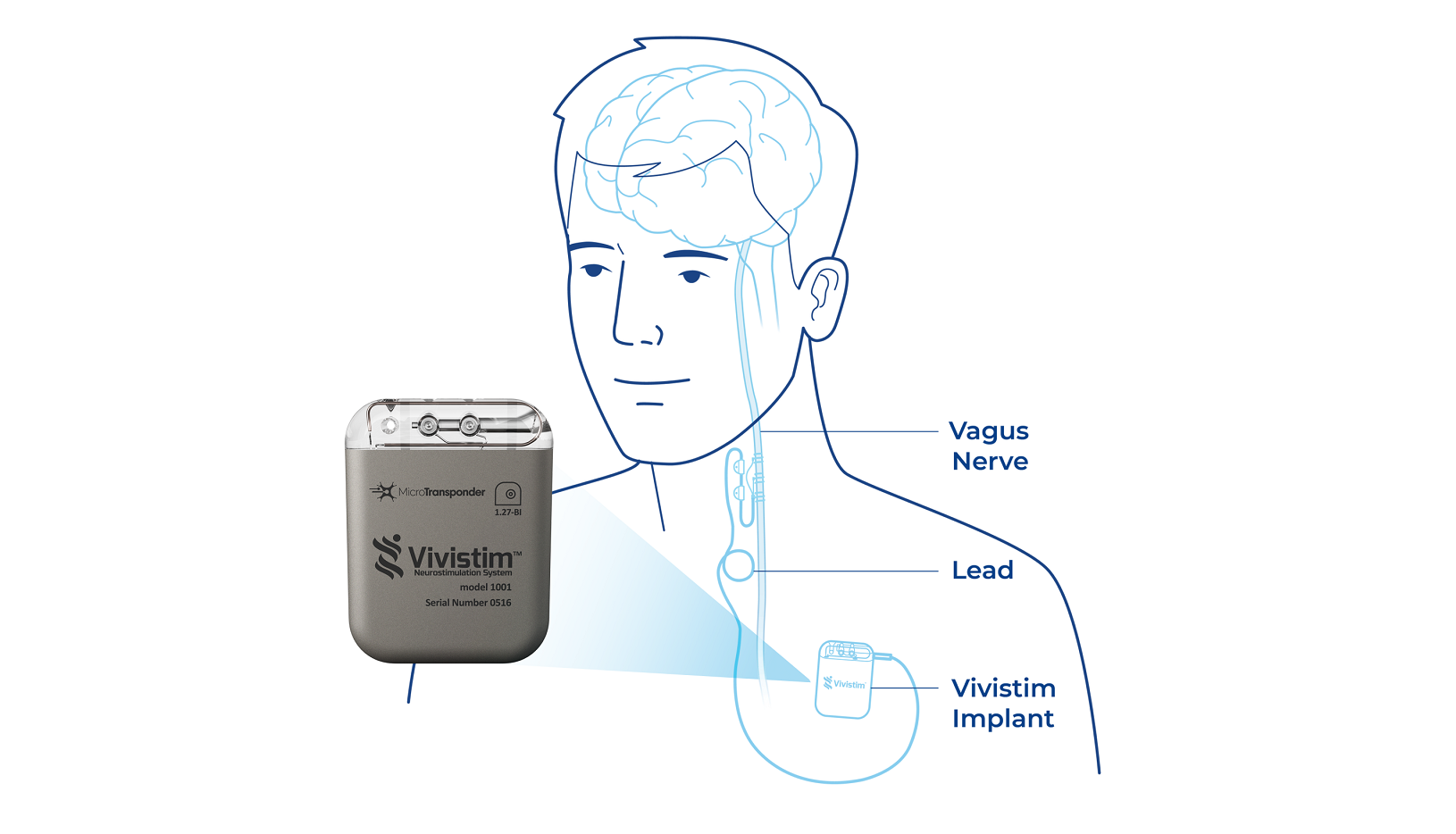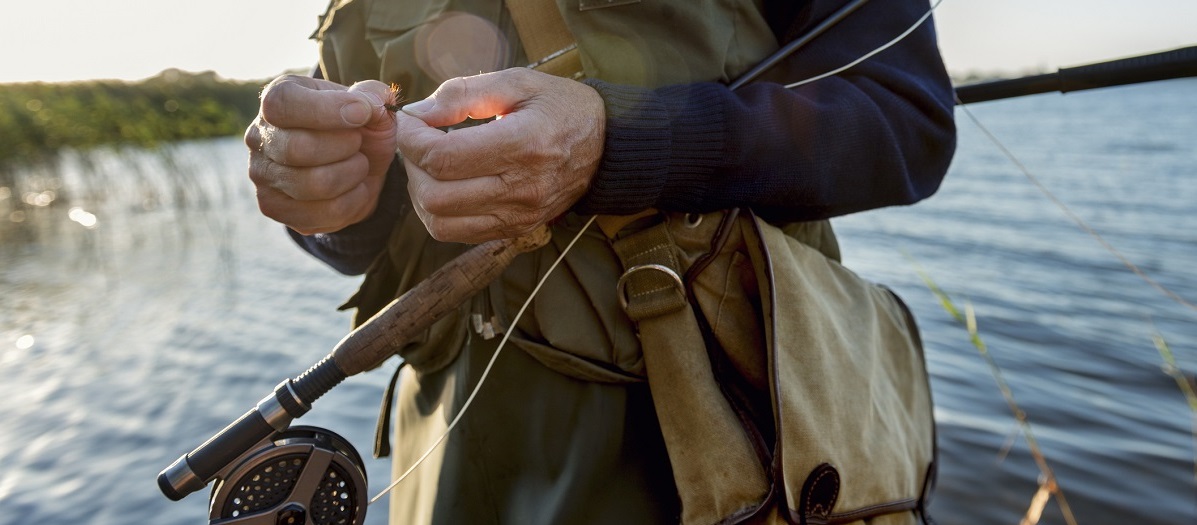Enhanced Stroke Recovery Program
A small, implanted device helps stroke survivors regain hand and arm function when used in combination with occupational therapy.
Paired VNS Therapy for Stroke

A device that uses brain stimulation helps people who’ve had a stroke regain hand and arm function to become more independent and improve their life quality.
After a stroke, more than half of survivors still have trouble moving their arms and hands. Carilion Clinic uses advanced technology to help make patient’s arms and hands work better, even if regular therapy didn't help previously. Through our enhanced stroke recovery program, a team of neurosurgeons, neurologists, occupational therapists and other specialists collaborate to provide expert care, specific to each patient. Vagus nerve stimulation (VNS) paired with occupational therapy helps patient's arm and hand function improve. With this paired treatment, patients see two to three times more improvement after six weeks compared to just doing therapy alone. This treatment can help even if the stroke happened a long time ago.
Many patients report improved quality of life, such as:
- Increased mobility
- Improved ability to care for themselves
- Feeling happier
How It Works
What is Vagus Nerve Stimulation?
Vagus Nerve Stimulation (VNS) is a surgical procedure used to treat various brain disorders. It's approved by the FDA to treat specific cases of epilepsy, treatment-resistant depression and impaired upper limb function due to an ischemic stroke. Compared to deep brain stimulation, VNS is less invasive and works by sending electrical pulses through the vagus nerve to the brain. This nerve is part of the autonomic nervous system, which controls involuntary body functions. In stroke survivors, VNS electrical pulses release neuromodulators (brain cell impulses and chemical signals that transfer information between the brain and the rest of the nervous system), helping to form or strengthen neural connections. This enhances the effectiveness of occupational therapy and improves upper limb function.
Those that benefit from treatment most include:
- Chronic ischemic stroke survivors who have been active in occupational therapy, but have not yet regained hand and arm function
- People who have experienced a stroke, months, even years ago, who continue to experience moderate to severe hand and arm function
Ask your physician if Paired VNS Therapy may be right for you!
Paired VNS Therapy Steps
- A medical device, small enough to fit in the palm of your hand, is surgically implanted under the skin in the upper left chest area during an outpatient procedure.
- Following the implant procedure, patients typically return home the same day.
- After a week of recovery from the implant procedure, patients continues in-clinic occupational therapy for at least six weeks.
- During occupational therapy, our team of experts use a wireless transmitter that communicates with software to signal the implanted device to deliver a gentle pulse to the vagus nerve while the stroke survivor performs specific tasks, such as flipping a coin, shaking a hand, cutting food, etc.
- While performing routine tasks at home, patients may self swipe the device magnet activator over the implant area to activate the system.
Patients likely won’t feel the stimulation but will notice improvement in hand and arm function over time.
Is Treatment Right for Me?

You may be a candidate for our expanded stroke recovery program if you experience reduced function of your arms or hands following a stroke.
Paired VNS Therapy, which includes neurosurgery and occupational therapy, is covered through most insurances. To confirm coverage, contact your insurance carrier prior to your appointment. It is possible that you may be responsible for copays or coinsurance.
To determine if treatment is right for you, call 540-512-1440 for more information, or to schedule a consultation.
Frequently Asked Questions
What is Paired VNS Therapy?
The vagus (VAY-gus) nerve runs up the sides of the neck and into the brain. The vagus nerve stimulation (VNS) implant, made by Vivistim, sends electrical pulses to the nerve, which carries the pulses to the brain. Pairing VNS with occupational therapy can help create new neural pathways.
How do I find out if I am eligible for Paired VNS Therapy?
To determine if you are eligible for Paired VNS Therapy, you will undergo an initial assessment with an occupational therapist to evaluate your current hand and arm function. You will then be referred for a consultation with a surgeon to determine if you are a good candidate for the implantation procedure.
Is Paired VNS Therapy approved by the FDA?
The use of a paired VNS for the treatment of moderate-to-severe upper extremity motor deficits associated with chronic ischemic stroke is approved by the US Food and Drug Administration. This treatment aims to increase the task-specific neuroplasticity through the activation of cholinergic and noradrenergic networks during occupational therapy.
Can I feel the implant?
Most people will not feel the implant under their skin. Immediately after the procedure, you may have some soreness in your upper chest where the device was implanted, but it should resolve in time.
Can I feel the stimulation?
Typically, people do not feel the pulses during stimulation. Settings can be adjusted by your clinician or therapist during your in-office visit to make Paired VNS comfortable for you.
What sort of improvement can I expect?
Response to treatment varies for each person. In a clinical trial, Paired VNS Therapy study subjects experienced 2-3 times more improvement in hand and arm function than those who received intense occupational therapy without Paired VNS.
How quickly will it work?
In a clinical trial, Paired VNS Therapy study subjects reported improvement as early as 2-3 weeks. Individual results may vary.
How long does the battery last?
The battery is expected to last approximately five years at typical settings. Your specific situation and settings may result in shorter or longer battery life. During scheduled visits with your clinician, they will use the system software to check the battery status of your implant.
What happens if I stop using it?
As you perform your prescribed at-home therapy, you may continue to see improvement in your hand and arm function. Stopping Paired VNS Therapy does not inherently have adverse effects but may slow down or stop your progress. Talk to your clinician to learn more.
Can the system be removed when I have achieved my goals, or if I change my mind?
The implant may be removed at any time, in a same-day outpatient procedure. Depending on your surgeon’s decision, all or part of the implants can be removed at any time. Talk with your surgeon for further details.
Are there side effects?
Some common side effects of VNS Therapy include hoarseness, shortness of breath, throat irritation, pain, and coughing. Infection may be a risk associated with implantable surgeries. Please see vivistim.com/safety for more safety information.
Does Paired VNS Therapy use medication?
No. Paired VNS Therapy is an implanted device and system used in conjunction with rehabilitation therapy.
Can I speak to someone who has used the Vivistim Paired VNS System?
Yes! Reach out to MicroTransponder Customer Service at 855-628-9375 or customerservice@microtransponder.com to put you in touch with a Vivistim user or a occupational therapist specialized in Paired VNS Therapy.
Can I travel?
Yes. There are no specific travel restrictions. Flying will not affect the system or the delivery of stimulation. You may want to inform the airport or security personnel that you have an implant by showing your Patient Identification Implant Card. Properly operating metal detectors are not expected to affect the implant.
Are there any restrictions after the surgical procedure?
Once you have the implant, you should not undergo Diathermy or Vagotomy. Also, talk to your physician if you wish to participate in contact sports.
Are there MRI restrictions?
Certain types of MRI can be performed, provided specific guidelines are followed. Before scheduling an MRI, contact your neurosurgeon or primary care physician.
What should I do if I lose my implant Magnet?
For a replacement magnet, please contact MicroTransponder Customer Service at 855-628-9375 or customerservice@microtransponder.com.
Will my implant turn on if I walk past a magnet, like one on a refrigerator?
Walking past a household magnet will not affect an implanted device. Household magnets are generally not strong enough to activate the device. Stronger magnets would need to be swiped directly over the implant area to affect the device.
What is the purpose of the Patient Identification Implant Card?
The wallet-sized card lets others know you are using a VNS implant. It will also make them aware of MRI conditions, your neurosurgeon’s name and phone number and implant product information.
How can I review the implant instructions?
Visit the Vivistim website (Vivistim.com) to review the patient manual and MRI safety information.
How can I reach my neurosurgeon and care team?
We’re here to help. To schedule a consultation or follow up appointment, email StrokeRecovery@carilionclinic.org or call 540-512-1440.
Meet the Experts

Melissa Martinez, FNP-C
Brain Injury Medicine
Physical Medicine and Rehabilitation
Contact Us
We’re here to help. To learn more, or to schedule a consultation, call 540-512-1391.


